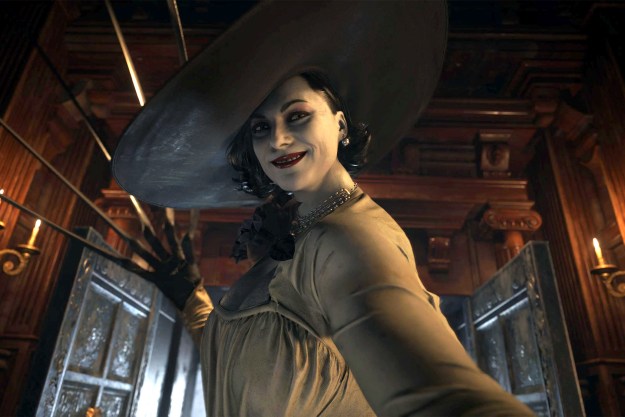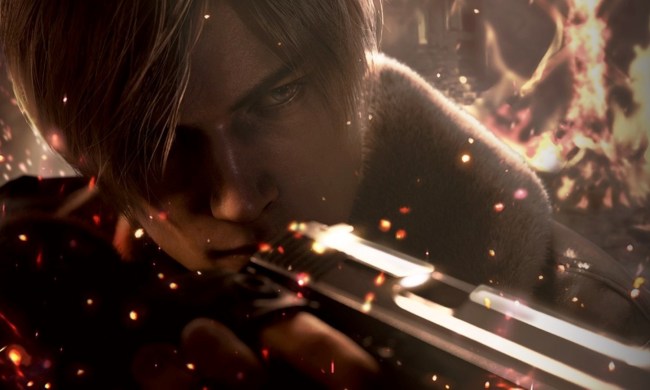
“Resident Evil Village boils all the best and worst parts of the franchise down into an eclectic, though uneven experience.”
- Creative worldbuilding
- Memorable set pieces
- Rewarding exploration
- Compactly designed village
- Uneven structure
- Weak action
- Lacks tension
If Resident Evil 7 was a return to form for gaming’s most iconic horror franchise, Resident Evil Village is a full-blown identity crisis. Not content to simply repeat the success of its predecessor, the new installment crams 25 years of history into eight hours. It’s not the best Resident Evil game, but it might be the most Resident Evil game.
That’s both good and bad news for fans of the shape-shifting franchise. Everything that players loved about classics like the original game and Resident Evil 4 is present in the new game’s DNA. That’s just as true in the opposite direction, too, as Capcom has put together a big, bold franchise retrospective that doesn’t cover up the warts.
Resident Evil Village works best when it’s serving up atmospheric exploration that cleverly expands on the franchise’s puzzle box roots. It’s less fun as an action-packed first-person shooter. That clash of styles represents the entire series in a nutshell.
A horror anthology
Resident Evil Village picks up three years after the events of 7. Charisma black hole Ethan Winters has settled down with his wife, Mia, and baby, Rosemary, following the whole Louisiana incident. His domestic paradise crumbles when Chris Redfield makes a shocking entrance. Ethan finds himself looking for his family in a creepy European village that’s infested with lycans, vampires, and more (oh, my!).
Like many elements of the game, the story is a little all over the place. It offers up some excellent scares early on as Ethan is overwhelmed by vicious werewolves that make the franchise’s old zombies seem sweet. The tone quickly becomes sillier as the game introduces its colorful cast of characters. Structurally, it’s a horror movie anthology where each character headlines their own monster flick.
Sometimes, that flow really works. The Lady Dimitrescu (“the tall vampire lady”) section of the game plays like a mini version of Resident Evil 2 where players creep around a big castle, solving puzzles and running from vampires that persistently stalk the halls. It’s a self-contained B-movie that packs a ton of intriguing worldbuilding into a concise two-hour stretch.
One particular section, which I won’t spoil, serves up both the best horror and puzzle work the series has ever done in the same breath. The focused brevity only makes it that much stronger.
It’s a gleeful exploration of genre clichés that gets to spread its grotesque wings and play with something other than zombies.
Other vignettes aren’t as successful. One later section invokes 1990s horror-action flicks like Lake Placid, and mostly manifests as a chase scene that trades in tension for simple platforming puzzles. Push a crate, press some buttons, avoid some obvious scripted death traps. Ironically, the more it leans into action-horror motifs, the less exciting it is to actually play.
While some ideas match the game’s mechanics better than others, it’s nice to see the series’ horror nerd roots on full display here. It’s a gleeful exploration of genre clichés that gets to spread its grotesque wings and play with something other than zombies.
Making my way downtown
Resident Evil Village may look like a departure for the series on its surface, but most of its new features are a clever iteration of the franchise’s design staples. That’s most apparent in the game’s titular village. It’s more open than a standard Resident Evil mansion, but it quietly functions the same way. The village is one big puzzle box that players slowly unlock as they progress.
Some of the game’s best moments simply come from atmospheric stretches of exploration. There are so many little rewards tucked away in different corners of the map. It’s not quite a sprawling open world, but that’s why it works. It’s a compactly designed village where each little hut is worth exploring.
In a game full of instantly iconic characters, the village itself is the real star of the show.
Every new feature serves the village. A Last of Us-style crafting system acts as a clever evolution of item combination and gives more reasons to scavenge. There’s a traveling merchant (a deliberate nod to Resident Evil 4) who sells weapon upgrades and ammo in exchange for pillaged valuables. There are even a handful of small side-quests, which encourage thorough scavenging while telling some micro-stories that explore the history of the decaying town.

Some ideas feel like light experiments that are auditioning for a full role later on. Take the new cooking system, which rewards players with health boosts when they hunt down animals hidden throughout the town. With only a small handful of recipes to complete, it feels like Capcom is only testing the waters for a sequel. In general, Village plays like an anniversary survey that’s designed to help the studio figure out where to take things next.
It’s not the best version of what it could be, but every little piece helps create a Resident Evil game that emphasizes the strengths of previous locations. In a game full of instantly iconic characters, the village itself is the real star of the show. Sorry, Lady D fans.
Power struggle
Just about every beloved Resident Evil release has the same problem. While they generally start as frightening horror games that take power away from the player, they inevitably conclude with an inferior action set piece. Village once again commits that sin, but it’s more frustrating than ever. The back third of the game suddenly transforms into a dull corridor shooter that lays the self-serious melodrama on thick (I have to emphasize this: Ethan Winters might be the most boring hero in all of video games).

The weapons don’t feel built for fast shootouts with dozens of enemies. They’re slow, almost archaic. That works during horror sequences where players struggle to get shots off on a fast-approaching lycan. It’s less fun when blasting away at waves of bullet-sponge enemies later in the game. The same mechanics that are built to instill panic are used to fuel an action power fantasy. It just doesn’t mesh.
That’s apparent in the game’s bonus Mercenaries mode, where players rush to kill a set number of monsters within a short time period. Slow movement and sluggish gunplay just make the mode feel like it’s running at half speed, as if Ethan is shooting while sinking in quicksand.
With each dramatic beat having no lasting impact on the story, any sense of danger is lost early on.
This conflict is a running theme throughout the game; players are meant to feel powerless and powerful at the same time. Those ideas trample on one another, weakening both ends of the spectrum. During the story, we see truly horrific things happen to its characters that are quickly brushed off as “just a flesh wound.” As soon as it starts feeling like any injury can be cured with magic health potions, all the stakes and tension go out the window. Body horror becomes slapstick comedy.
It begins to feel like certain scenes are only there for pure shock value — and that effect wears thin fast. With each dramatic beat having no lasting impact on the story, any sense of danger is lost early on. The fact that players can just pop into a menu and craft ammo mid-fight feeds into that, too; nothing bad ever really happens despite all the gore. With no consequences, risks, or stakes, I played through the entire back half of the game stone-faced with nothing phasing me. That’s the kind of tepid reaction that horror movies fear.
Is Resident Evil a series about puny humans narrowly surviving terrifying situations? Or is it about pseudo-superheroes triumphantly gunning down mutants? Resident Evil Village idles in front of that crossroads instead of choosing a path.
Our take
Resident Evil Village is an uneven anthology of horror movie send-ups. Sometimes it offers a truly exciting vision of the series’ future with imaginative world-building and rewarding exploration. Other times, it’s a fairly run-of-the-mill shooter that struggles to provide any real stakes or tension. Those two tones are often at odds with one another, highlighting all of the franchise’s best and worst instincts in one eclectic package. Chalk it up to a quarter-life crisis.
Is there a better alternative?
A lot of previous Resident Evil games do what Village does, but in a more focused manner. Try 2 for the exploration, 3 for the action, or 7 for the horror.
How long will it last?
The story is around eight to 10 hours long, though there’s a lot of incentive to replay it to unlock new weapons and art. The Mercenaries mode adds a little extra playtime, too. You can also add Resident Evil Village mods to change the game entirely.
Should you buy it?
Yes. It’s a real toss-up of a question. This is still a fascinating entry in the iconic series even if it’s unsuccessful at times. But those who haven’t already bought in should steer clear, regardless of how much they want to meet Lady Dimitrescu.



